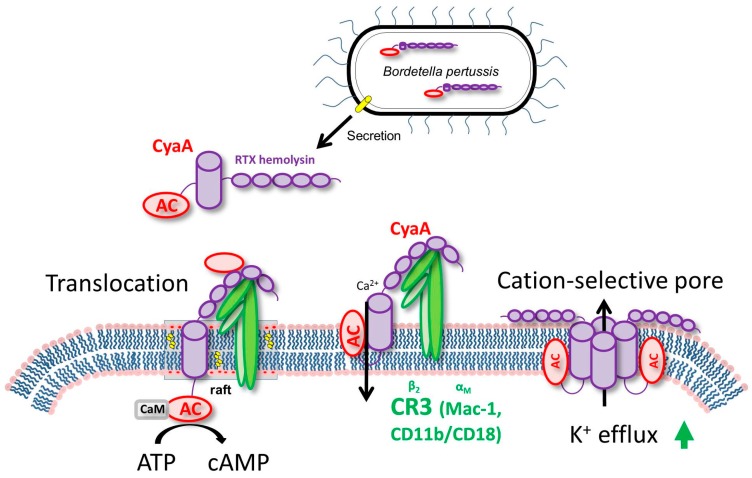cyaA on:
[Wikipedia]
[Google]
[Amazon]
Adenylate cyclase toxin (CyaA) is released from bacterium
 Inserting in the cell’s membrane results in an influx of calcium ions that leads to a calpain-mediated cleavage of
Inserting in the cell’s membrane results in an influx of calcium ions that leads to a calpain-mediated cleavage of
Bordetella pertussis
''Bordetella pertussis'' is a Gram-negative, aerobic, pathogenic, encapsulated coccobacillus of the genus ''Bordetella'', and the causative agent of pertussis or whooping cough. Like '' B. bronchiseptica'', ''B. pertussis'' is motile and expre ...
by the T1SS (Type 1 secretion system) and released in the host’s respiratory tract in order to suppress its early innate and subsequent adaptive immune defense.
CyaA plays a particular role in the early phases of airway colonization. It is able to instantly ablate the bactericidal oxidative burst, along with the opsonophagocytic killing capacities of neutrophil
Neutrophils (also known as neutrocytes or heterophils) are the most abundant type of granulocytes and make up 40% to 70% of all white blood cells in humans. They form an essential part of the innate immune system, with their functions varying in ...
s and macrophage
Macrophages (abbreviated as M φ, MΦ or MP) ( el, large eaters, from Greek ''μακρός'' (') = large, ''φαγεῖν'' (') = to eat) are a type of white blood cell of the immune system that engulfs and digests pathogens, such as cancer cel ...
s. As a result, it enables establishment of Bordetella infection of airway mucosa and promotes immune evasion of B. pertussis, by affecting the host’s immune cells.
Structure
The toxin is a 1706 residue-long polypeptide that consists of an N-terminal ~400 residue-longadenylate cyclase
Adenylate cyclase (EC 4.6.1.1, also commonly known as adenyl cyclase and adenylyl cyclase, abbreviated AC) is an enzyme with systematic name ATP diphosphate-lyase (cyclizing; 3′,5′-cyclic-AMP-forming). It catalyzes the following reaction:
:A ...
(AC) enzyme that is linked to a characteristic RTX hemolysin (Hly) moiety of ~1300 residues. This Hly moiety itself consists of four functional subdomains, comprising: (i) a hydrophobic pore-forming domain ; (ii) an activation domain, with the two posttranslationally acylated lysine residues; (iii) a receptor-binding RTX domain consisting of ~40 typical calcium-binding RTX nonapeptide repeats]; and (iv) a non-processed C-terminal secretion signal recognized by a bacterial type I secretion system (T1SS), respectively.
Mode of action in host cells
Once in host cells, CyaA binds the complement receptor 3 (CR3), the αMβ2 integrin known also as CD11b/CD18 or Mac-1. Then, the toxin translocates its AC enzyme domain across the cytoplasmic membrane of Macrophage-1 antigen, CR3-expressing myeloid cells, such as macrophages, neutrophils and dendritic cells. Inserting in the cell’s membrane results in an influx of calcium ions that leads to a calpain-mediated cleavage of
Inserting in the cell’s membrane results in an influx of calcium ions that leads to a calpain-mediated cleavage of talin Talin may refer to:
Places
* Talin, Armenia, a city
* Tálín, a municipality and village in the Czech Republic
*Tallinn, capital of Estonia
* Talin, Iran, a village in West Azerbaijan Province
*Talin, Syria, a village in Tartus Governorate
Other
...
. The CyaA–CR3 complex relocates into lipid rafts and the AC domain is translocated across the cellular membrane into the transmembrane region, where signaling complexes, such as protein kinase A
In cell biology, protein kinase A (PKA) is a family of enzymes whose activity is dependent on cellular levels of cyclic AMP (cAMP). PKA is also known as cAMP-dependent protein kinase (). PKA has several functions in the cell, including regulatio ...
, are clustered.
Inside the cells, the AC enzyme binds calmodulin
Calmodulin (CaM) (an abbreviation for calcium-modulated protein) is a multifunctional intermediate calcium-binding messenger protein expressed in all eukaryotic cells. It is an intracellular target of the secondary messenger Ca2+, and the bind ...
and catalyzes unregulated conversion of ATP into the key second messenger molecule 3',5'-cyclic adenosine monophosphate (cAMP). cAMP is responsible for the incapacitation of the bactericidal activities of the target cells. The RTX hemolysin part of CyaA is functionally independent of AC domain and forms oligomeric cation-selective pores that allow cytosolic potassium ion
Potassium is the chemical element with the symbol K (from Neo-Latin '' kalium'') and atomic number19. Potassium is a silvery-white metal that is soft enough to be cut with a knife with little force. Potassium metal reacts rapidly with atmosphe ...
s to leak from cells via the cellular membrane.
Interference with immune defence
The fast production of very high levels of intracellular cAMP in CD11b-expressing immune cells that encounter CyaA, immediately interferes with the physiological functions of phagocytes. In monocytes and macrophages, the CyaA-produced cAMP signaling through the cAMP/protein kinase A (PKA) pathway blocks the production of reactive oxygen species (ROS). This also halts the complement-mediated uptake of opsonized particles. At higher CyaA doses, FcR-mediated phagocytosis is also inhibited. Through cAMP signaling, CyaA also alters TLR-triggered maturation of dendritic cells, inhibiting proinflammatory IL-12 and TNF-α secretion and enhancing IL-10 production and Treg expansion, preventing the induction of adaptive immune responses to Bordetella infections. The enzymatic AC activity of CyaA also seems to prolong the intracellular survival of non-opsonized internalized (invading) B. pertussis bacteria that enter into human and murine macrophages by a non-phagocytic mechanism.See also
*Pertussis toxin
Pertussis toxin (PT) is a protein-based AB5-type exotoxin produced by the bacterium ''Bordetella pertussis'', which causes whooping cough. PT is involved in the colonization of the respiratory tract and the establishment of infection. Res ...
* Anthrax toxin
Anthrax toxin is a three-protein exotoxin secreted by virulent strains of the bacterium, '' Bacillus anthracis''—the causative agent of anthrax. The toxin was first discovered by Harry Smith in 1954. Anthrax toxin is composed of a cell-bind ...
References